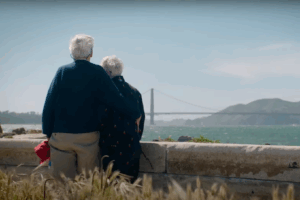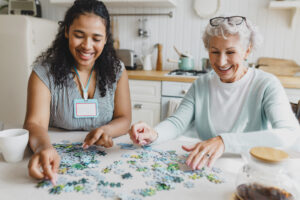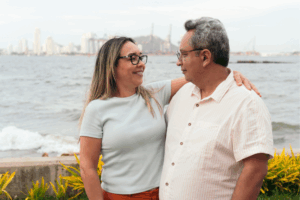The day before my dad died, everyone in the family went to see him. It was a coincidence, more or less. His health had been up and down, and home hospice had been set up for him. The weather the next week was supposed to be miserable, record-breaking rain in San Francisco, so everyone wandered over to the house that day to say, “hi,” and spend some time before the storms hit.
It was one of his best days in a long time. We all came and went at different times: children and their spouses, grandchildren, everyone. He had the energy not to even take a nap. He was just laughing and happy the whole day, especially when he held his two new granddaughters in his good arm.
He fell asleep that night, in his own bed, in a house he had bought with the fruit of his work and in which he raised his family, and never woke up. His last day was one of love.
And that’s how he wanted it. A few months before, he had spent hectic, light-blaring, and mechanical days in the hospital and made it clear he would never be going back. That’s why, when he started the final journey a couple of months after that, we arranged for home hospice.
In-home end-of-life care may not be for everyone. But for more and more people, it is a way to make sure that your final days are peaceful and happy. It is part of our theory of aging in place: that to be surrounded by your lifetime of memories makes the time of death a sweet and fitting experience. It is an option with many benefits, and if your aging loved one is looking toward their final stage, it is one worth looking into.
The Importance of Talking About Options
The truth is, most people don’t want to think about dying. And even when they do, their family members and loved ones don’t want to talk to them about it. We want to push it out of our minds, as if being cheery can impede the inevitable. It’s part of our overall unhealthy attitudes toward death (which, thankfully, are changing).
Recent statistics reveal more about our cultural unwillingness to talk about the end of life:
- 24% of Americans have put their end-of-life wishes in writing.
- 16% have thought about their end-of-life wishes but not put them in writing.
- 19% haven’t thought about their end-of-life wishes at all.
In fact, more Americans are more willing to have the conversation with their children, an oft-mortifying spectacle, than they are willing to talk to their own parents about the one inevitable fact of life. And that means we too often move toward the default: dying in a hospital. Even if that is not what a person wants, a lack of communication and a lack of knowledge about options makes it the only choice.
Why People Are Choosing In-Home End-of-Life Care
But being in a hospital is not the only choice. Please don’t get us wrong: The staff at any hospital is filled with amazing people, who work incredibly hard and are extremely underappreciated. But a hospital’s job is to keep you alive. So the last moments tend to be spent working toward saving, not letting go.
And more than that, the hospital isn’t home. Yes, many hospitals now offer hospice care, and there are dedicated hospice facilities filled with people who will take care of your loved one. We all owe a debt of gratitude to them, and hospice centers should be fully funded.
But there are many advantages to having in-home end-of-life care. These include:
- Less red tape: There are many rules and regulations that come with out-of-home hospice care, including multiple hospital procedures that families have to be cognizant and respectful of, paying attention to them instead of to their loved one. (In any situation, community living services at Institute on Aging can help you navigate bureaucracy.)
- More personalized care: In a hospital or designated hospice facility, there are many patients and many people in need. At home, treatment can be more personalized, set up the way the dying person and their loved ones wish.
- More flexible schedules: Hospice care is usually 24-hours on call and can fit around the work schedules of you and your family. There aren’t designated visiting hours.
- Reduced costs: In general, families spend anywhere from $10 to $100 less per day for home hospice than in a hospital. This can quickly add up, and thanks to newer programs, Medicare and Medicaid pay for home care.
- Familiarity: Perhaps the most common reason people want to die at home is because they are in a familiar place. They have the items they’ve treasured and the memories they’ve made. They aren’t in a new environment, maybe being moved from room to room. The end is where they’ve planted their roots, not a new rootlessness.
- Dignity: There is a dignity to being able to say, “This is where I have laid my hat in my life; this is where I shall lay my body.” We believe that aging isn’t about being fit into boxes. It is about choices. And having the choice of where to spend your final moments is a strong and empowering one.
- Peace: Hospitals are noisy, filled with beeping instruments and the rush of emergency. Even in a hospice setting, there are people moving, the machinery of work. Being at home means having a chance to say goodbye on your own terms, with the ones you love.
With in-home, end-of-life care, dedicated, professional workers, who are as knowledgeable about medicine as they are about people, help to guide aging adults and their families down a peaceful path in the final journey. And, most importantly, your aging loved one has a choice in the matter.
As we get older, it’s too often the case that society takes decision-making power away from us. In-home end-of-life care is one way to empower older adults to continue making decisions about their lives, including making the final decision: the location of death. It shouldn’t be taboo. It should be a decision that is celebrated as another expression of the amazing, unique, and loved person your family member has always been. It is a celebration of being themselves. It’s a celebration of being at home.
At Institute on Aging, we help older adults age in place. Our programs and services help aging adults carry out their end-of-life wishes with their families and caregivers at their sides. Connect with us today to learn more.







